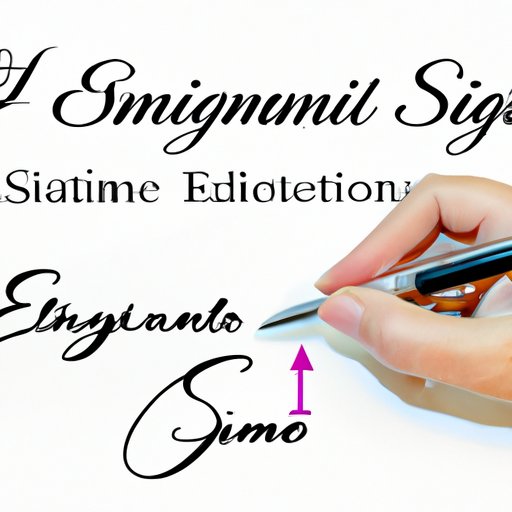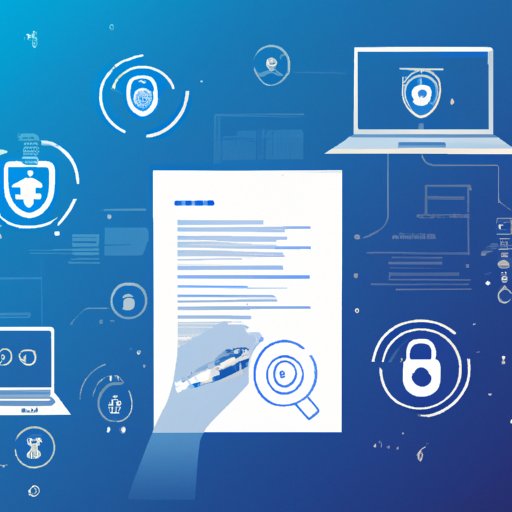Introduction
Electronic signatures (e-signatures) are digital versions of traditional handwritten signatures used to authenticate documents and agreements online. E-signatures are legally binding and can be used for a variety of purposes such as signing contracts, making payments, or verifying identity. This article will explore how e-signatures work and provide a step-by-step guide to setting up an e-signature system.
Definition of Electronic Signatures
An electronic signature is a type of technology that allows individuals to sign documents electronically. It is an encrypted form of authentication that verifies the identity of the signer and the integrity of the document being signed. An electronic signature can be used to authenticate transactions, agreements, and other documents, making it easier and faster to complete processes.

Overview of Benefits and Features
E-signatures offer several benefits over traditional paper-based signatures. They are fast, secure, and reliable, and can be used to streamline processes, reduce costs, and increase efficiency. In addition, they enable businesses to comply with legal and regulatory requirements. The following are some of the key features of e-signatures:
- Secure – E-signatures use encryption technology to ensure that the signature is valid and secure.
- Convenient – E-signatures can be used anytime, anywhere, and on any device.
- Legal – E-signatures are legally binding and enforceable in most countries.
- Cost-Effective – E-signatures reduce the need for printing, mailing, and scanning documents, resulting in cost savings.
- Flexible – E-signatures can be used for a variety of purposes, including contracts, payments, and identity verification.
Step-by-Step Guide to Setting Up an Electronic Signature System
Setting up an electronic signature system requires careful planning and preparation. Here is a step-by-step guide to setting up an e-signature system:
Choosing the Right Software
The first step is to choose the right software for your needs. There are a number of different e-signature software solutions available, so it is important to do your research to find the one that best suits your needs. Consider factors such as the features offered, the cost, the ease of use, and the level of security.
Understanding Security Requirements
The next step is to understand the security requirements of your e-signature system. This includes ensuring that the system meets all security and data privacy standards, such as those set by the European Union’s General Data Protection Regulation (GDPR). You should also ensure that the system has adequate protection against fraud and malicious activity.
Establishing the System
Once you have chosen the right software and understood the security requirements, you can begin to establish the system. This involves setting up the software, configuring the settings, and testing the system. Once the system is up and running, you can start using it to securely sign documents.

An Overview of Electronic Signature Regulations and Compliance
In order to use e-signatures legally, it is important to be aware of the relevant laws and regulations. Different countries have different laws and regulations governing the use of e-signatures, so it is important to familiarize yourself with the applicable laws and regulations before using e-signatures. Here is an overview of the federal, state, and international laws and regulations that apply to e-signatures:
Federal Laws and Regulations
In the United States, the use of e-signatures is governed by the Electronic Signatures in Global and National Commerce Act (ESIGN), which was passed in 2000. This act provides a legal framework for the use of e-signatures and outlines the rights and responsibilities of both parties when using them.
State Laws and Regulations
In addition to the federal laws and regulations, each state has its own laws and regulations governing the use of e-signatures. It is important to familiarize yourself with the applicable state laws and regulations before using e-signatures in your business.
International Laws and Regulations
The European Union has adopted the eIDAS Regulation, which establishes a legal framework for the use of e-signatures across Europe. This regulation sets out the rules and requirements for the use of e-signatures in European countries and ensures that they are legally binding and enforceable.

How to Implement an Electronic Signature System in Your Business
Implementing an electronic signature system in your business requires careful planning and preparation. Here are some steps to help you get started:
Preparing Documents and Forms
The first step is to prepare the documents and forms that will need to be signed electronically. This includes creating the documents, formatting them for electronic signing, and ensuring that they meet the required legal and regulatory standards.
Training Employees
It is also important to train employees on how to use the system. This includes providing instructions on how to create, format, and sign documents electronically. Additionally, it is important to ensure that employees understand the security protocols and procedures that must be followed when using the system.
Setting up a Secure Environment
Finally, it is important to ensure that the system is secure. This includes setting up access controls, establishing user authentication protocols, and implementing appropriate security measures. It is also important to ensure that the system is regularly monitored and updated to ensure that it remains secure.
Examining the Impact of Electronic Signatures on Document Security
Using electronic signatures can have a significant impact on the security of documents. Here are some of the key benefits of using e-signatures:
Improved Authentication
E-signatures provide improved authentication of documents, as they can be used to verify the identity of the signer. This helps to prevent fraud and ensures that only authorized individuals are able to sign documents.
Reduced Risk of Fraud
E-signatures also reduce the risk of fraud, as they require the signer to authenticate their identity before signing. This helps to ensure that the document is signed by the correct individual and that the contents of the document remain unchanged.
Increased Data Integrity
Finally, e-signatures help to improve the integrity of the data contained in the document. As the signature is encrypted and digitally verified, it is almost impossible to alter the contents of the document without detection.
Conclusion
E-signatures are becoming increasingly popular due to their convenience, speed, and security. They provide a secure, efficient, and legally binding way to sign documents electronically. By understanding the laws and regulations governing the use of e-signatures and taking steps to ensure the security of the system, businesses can reap the benefits of using e-signatures.
(Note: Is this article not meeting your expectations? Do you have knowledge or insights to share? Unlock new opportunities and expand your reach by joining our authors team. Click Registration to join us and share your expertise with our readers.)
